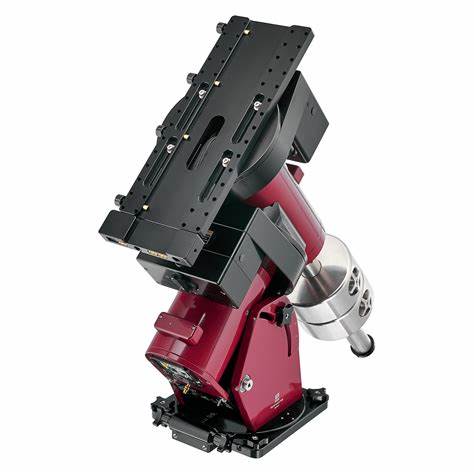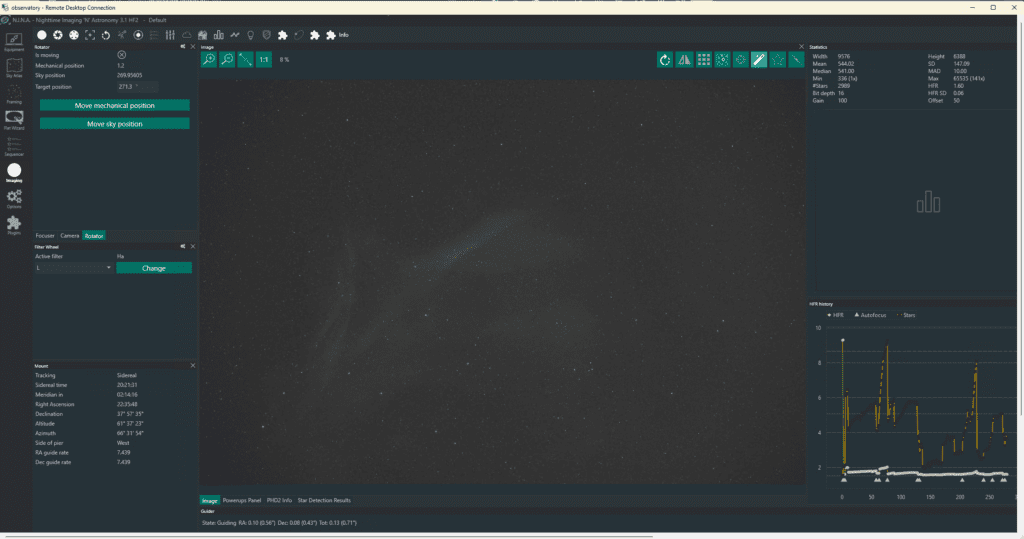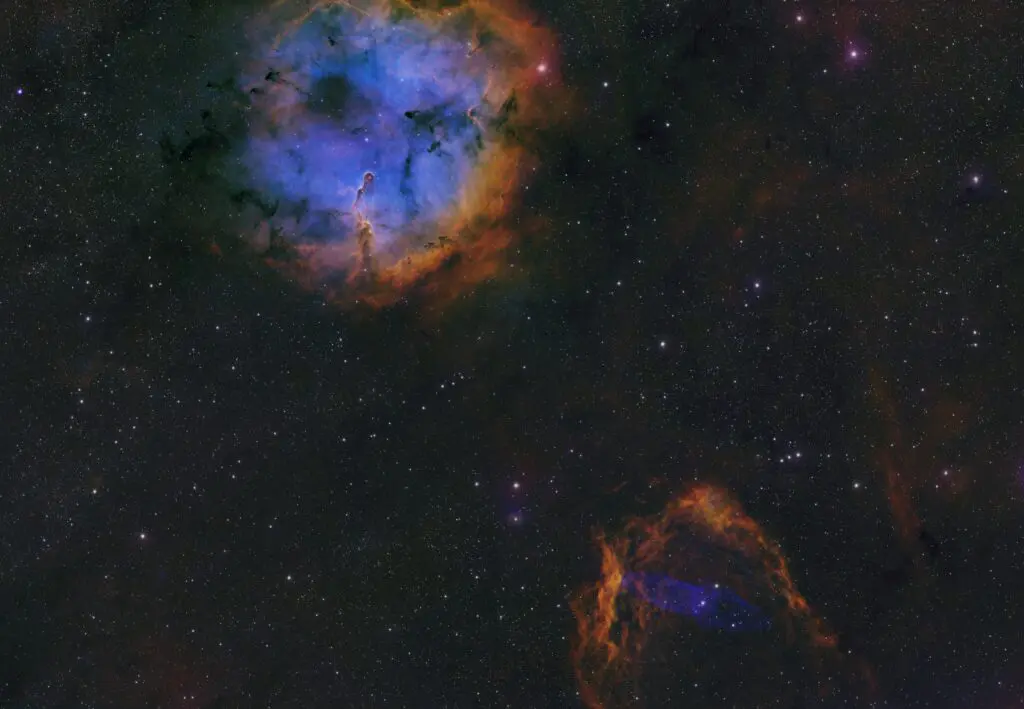Ever wondered what it takes to capture the breathtaking images of distant galaxies, nebulae, and star clusters that grace the pages of astronomy magazines and websites? Join us as we take you behind the scenes of operating a remote observatory nestled under some of the darkest skies on Earth.
The Allure of Dark Skies
The universe reveals its deepest secrets only when the conditions are just right. Our remote observatory is strategically located far from the glow of city lights, in a region where the night sky is a canvas of countless stars. Under these pristine dark skies, the Milky Way arcs overhead like a shimmering river, and even the faintest celestial objects become visible to our sensitive equipment.
But why are dark skies so crucial for astrophotography?
- Enhanced Visibility: Light pollution washes out the night sky, making it difficult to observe faint objects. Dark skies provide the contrast needed to capture the subtle details of distant galaxies and nebulae. Our passion is capturing that feint “IFN” and those dark dust clouds.
- Improved Image Quality: Reduced sky brightness allows for longer exposure times without saturating the image, resulting in clearer and more detailed photographs. This removes a lot of difficult gradient removal and post processing from your workflow leaving you a lot more time to extract nuance, texture and detail like never before.
- Access to Faint Objects: Some celestial phenomena are so faint that they can only be captured under exceptionally dark conditions. We bring this right to you very night we can image!
Our location not only offers these advantages but also presents unique challenges that make operating a remote observatory an adventure in itself.

Battling the Elements (and the Insects!)
Operating in a remote area means coexisting with nature in all its forms. One might imagine that the biggest challenges are technical, but sometimes, it’s the smallest inhabitants that make the biggest impact.
The Uninvited Guests: Bugs
- Insect Invasions: The warmth of our equipment can attract various insects seeking shelter. From tiny gnats to sizable beetles, we’ve encountered them all. Texas has no short supply of bugs that like to build nests from paper nests to mud nests to just moving into every space and crevasse they can find.
- Protecting the Gear: To prevent bugs from interfering with delicate instruments, we implement physical barriers like fine mesh screens and use environmentally friendly repellents. A little bit of mint smell does wonders to keep the flying insects away.
- Funny Anecdotes: I’m pretty sure there have been a few times when security cameras in neighboring facilities have seen me run out the observatory door when I notice the paper wasps moved in and are chasing me out.
Dealing with these critters requires patience and ingenuity, adding an unexpected layer to the science of astrophotography.
The Quest for Reliability: High-Quality Equipment
In a remote setting, reliability isn’t just a preference—it’s a necessity. Equipment failures aren’t just inconvenient; they can mean losing precious observation time and data. (and long trips back and forth to the observatory)
Selecting the Right Gear
- Robust Gear: From shielded USB cables to Battery Backup UPS and remote-controlled power and relay switches. We try and build redundancy into our entire system. It’s important that our systems have fail safes in order to protect our large investment in quality gear. We have cameras that watch for safety zones, sensors that assure equipment is safely parked before we close our roof and weather systems that detect cloud, rain, light, wind and other local weather factors that help us keep operating safely.
- Sensitive Cameras: Our observatory is equipped with state-of-the-art CMOS cameras that can capture the faintest light with remarkable clarity. They’re cooled down to -10c to limit dark current creating beautifully sharp, crisp and clear sub exposures.
- Automated Mounts: Precision mounts with automated tracking allow us to follow celestial objects across the sky with incredible accuracy. Our mount is calibrated with a 300-point model capable of unguided exposures up to 15 minutes with our current telescope. This has come in handy before when a USB cable failed on our guide cam. Our scope kept everything centered, aligned and guiding perfectly through the night until we were able to come in and replace the cables.

Redundancy and Backup Systems
- Power Solutions: Lightning suppression and backup batteries, keep the observatory running even in the event of a primary power failure. (Although we see this as an “unsafe condition” and will use our battery power to close up and secure the facility.
- Data Security: Redundant data storage ensures that the valuable images and data collected are safely preserved.
Investing in high-quality gear minimizes downtime and maximizes the potential for stunning astrophotography.
When Things Go Wrong: Equipment Failures
Despite our best efforts, the harsh reality is that equipment can—and does—fail. In a remote observatory, troubleshooting is a unique challenge.
Common Issues
- Mechanical Failures: Motors can burn out, gears can slip, and moving parts can seize due to dust or temperature extremes. We go through USB cables like they’re going out of style at times it seems. (Part of me wishes we could use ethernet cables and Power over Ethernet to connect our astrophotography gear and systems.)
- Electronic Glitches: Power surges or component failures can disable critical systems. You can try your best to make sure everything is fail safe and set to power back on when power is restored, but sometimes even the best computer set to power on during power restore can get into a weird state – or be stuck in safe mode/bios screen.
- Software Hiccups: Automation software may crash or behave unpredictably, halting observations. Especially when you add on mechanical and electrical problems. We log all of our issues to our discord server so we can try and have a rolling history of status and more importantly, work to reduce these errors and develop safety systems around them.
Remote Troubleshooting
- Monitoring Systems: We employ comprehensive monitoring to detect issues in real-time, including temperature sensors, camera status indicators, and power monitors and security systems.
- Remote Intervention: Many problems can be addressed remotely by restarting systems, updating software, or adjusting settings. We’re firm believers in automation and tooling so we employ this whenever possible to try and have our processes and systems repeatable.
- On-Site Maintenance: For issues that cannot be resolved remotely, scheduled maintenance trips are planned, often requiring meticulous preparation due to the observatory’s remote location. Nothing worse than driving a few hours realizing that the camera adaptor you brought with you was a female connector and you don’t have any male-to-male adaptors. We’ve learned to keep spares on site to reduce risk of what seems like an endless battle of adaptors and spacers.
Our team’s expertise and the robustness of our systems help us navigate these challenges, ensuring that we can continue to explore the cosmos with minimal interruption.
Operating remotely can lead to unexpected issues. Once, after updating our camera rotator control software, the 0-degree reference point inexplicably shifted. It took a few days of imaging to notice that we were losing focus and the centering and rotation of frames were erratic. Had we not heeded these warning signs, shut down, and visited the observatory to troubleshoot, the rotator might have detached from the image train entirely!
The Software Suite: Our Digital Command Center
Operating a remote observatory relies heavily on sophisticated software that controls every aspect of the observation process. We’re huge fans of NINA and we use an advanced sequence plus many public plugins and some of our own to run our observatory remotely.
Automation and Control
- Telescope Control Software: Allows precise pointing and tracking of celestial objects, automated slewing, and object scheduling. TheSkyX runs our Paramount MX mount with a 300-point pointing model with periodic error correction.
- Camera Control Programs: NINA Is our control center that manages exposure settings, image capture sequences, and initial data processing. We’re huge fans of the target scheduler plugin
- Mount and Dome Synchronization: Ensures that the observatory dome or roof moves in harmony with the telescope, preventing obstructions. Advanced optical sensors, relays and hall sensors help make sure our equipment is safely parked before the roof opens and closes and this orchestrates with the dome control capability within NINA.

Data Management
- Real-Time Monitoring: Live feeds and status updates keep us informed about the observatory’s performance. We have observability data for our network, imaging computers, live sky-camera, and local weather station.
- Data Transfer Protocols: High-speed gigabit data links transfer images and observational data to our main servers for processing and storage.
- Cloud Integration: Secure cloud storage provides accessible backups and enables collaborative projects with astrophotographers and astronomers worldwide and often within hours of imaging completion.
User Interface
- Remote Accessibility: Our systems are designed to be accessible from anywhere, allowing our team and clients to initiate observations and monitor progress from the comfort of their homes. Our systems are secured through a private VPN with remote access and authorization.
- User-Friendly Platforms: Intuitive interfaces make it easier for users of all experience levels to engage with the observatory’s capabilities. We do all the hard work, so you can use a familiar cloud experience to download the data. It’s like Dropbox for the cosmos 🙂
Our software infrastructure is the backbone of our operations, enabling us to offer seamless and efficient services to astrophotographers and researchers alike.

The Human Element: Passion and Expertise
Behind the technology and equipment is a team of dedicated individuals whose passion for astronomy drives the observatory’s success.
Our Team
- Astrophotographers: Experts who plan observation schedules, select targets, and ensure data quality.
- Technicians: Professionals who maintain equipment, develop software solutions, and troubleshoot issues.
- Customer Support: Staff who assist our clients, providing guidance and answering questions to enhance their experience.
Continuous Learning
- Staying Updated: The field of astronomy is ever-evolving. Our team stays abreast of the latest discoveries, technologies, and techniques.
- Community Engagement: We participate in astronomy forums, attend conferences, and collaborate with educational institutions to promote the science we love.
Our collective expertise ensures that whether you’re a seasoned astrophotographer or a curious novice, you’re in capable hands.
Bringing the Universe to You: Our Services and Offerings
We believe that the wonders of the universe should be accessible to all. That’s why we’ve designed our services to cater to a wide range of interests and experience levels.
Remote Imaging Sessions
- Customized Observations: Choose your targets and settings, and we’ll handle the rest. Receive high-quality images ready for your own processing.
Data Subscription Packages
- Regular Deliveries: Subscribe to receive new images and data on a regular basis, covering various celestial objects and phenomena.
- Exclusive Content: Gain access to rare observations and special events captured by our observatory.
Educational Programs
- Workshops and Tutorials: Learn about astrophotography techniques, image processing, and astronomy concepts through our online courses.
- Collaborative Projects: Participate in citizen science initiatives and contribute to real astronomical research.
Support and Community
- Personalized Assistance: Our team is available to help you make the most of our services, offering guidance tailored to your needs.
- Community Forums: Join a network of like-minded enthusiasts to share experiences, tips, and your own astrophotography work on our discord server.
Your Journey Awaits
Operating a remote observatory under pristine dark skies is a blend of cutting-edge technology, relentless problem-solving, and an unwavering passion for the cosmos. It’s about overcoming challenges—be it pesky insects, equipment malfunctions, or the complexities of remote operations—to unveil the hidden beauty of the universe.
We’re excited to share this journey with you. Whether you’re looking to capture your first image of a distant galaxy, contribute to astronomical research, or simply marvel at the night sky’s splendor, our observatory is your gateway to the stars.
Ready to embark on your astronomical adventure?
Check out our remote telescope imaging team or contact us today to learn more about how you can start exploring the universe from the comfort of your home.


